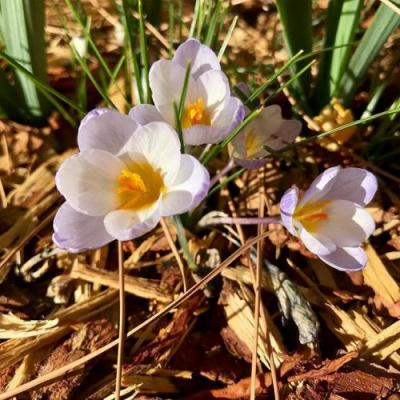May 22, 2021
Mulch Obliged
Few people are as excited about mulch as me. Maybe it’s the name. Maybe it’s time for a rebrand. Whatever you call it, mulch can be defined as any material (organic or synthetic) that’s added on top of the soil surface to benefit the soil, the plants, the gardener, or, in some cases, all of the above. Organic mulches are made of natural plant materials, like woodchips, shredded bark, pine needles, leaves, etc. Synthetic mulches consist of human-made materials, like recycled rubber bits or sheet plastic. Each mulch type has its list of pros and cons. Once applied, mulch may look like it’s just sitting there, existing, but that’s the beauty of it. Behind the scenes, mulches perform a variety of proven benefits—when applied correctly.
When I recommend mulching, I’m referring to the natural kinds, but both organic and synthetic mulches can provide the following benefits: inhibiting weeds, retaining soil moisture, slowing erosion, moderating soil temperature fluctuations (in winter and summer), and others. In addition to all of that, organic, natural mulches can add nutrients and organic matter to the soil as they break down and thereby help the roots of surrounding plants even more.
When we list the benefits of mulch, we tend to breeze through them collectively, but each benefit has a whole story with decades of research behind it. This week we’ll focus on weed control. It’s a doozy.

Question:
Why is a mulch depth of 4 inches such a common recommendation?
Answer:
That 4-inch rule is the minimum mulch thickness needed for controlling annual weeds when using coarse mulching materials (like woodchips or bark). The reason is that a thick layer inhibits weed seeds from germinating and growing by blocking sunlight. A much thicker layer of mulch may be needed to control perennial weeds fully, but we don’t have an exact number yet. In my own yard, sections mulched with 4 or more inches of chipped and ground woody materials have almost no annual weeds and only a half dozen or so perennial stalks poking up. The mulch was applied almost 2 years ago, and before that, it was a weedy nightmare cycle of London rocket in the cold season and an itchy, sneezy blanket of kochia and Palmer amaranth the rest of the year.
As mentioned above, there are pros and cons to each different kind of mulch, and these depend largely on particle size. In the recent University of California Agriculture and Natural Resources publication, Mulches for Landscapes, authors Drs. Jim Downer and Ben Faber include a helpful table titled “Benefits and problems associated with various mulch materials used in landscapes.” Comparisons are made between bark mulches; sawdust or finely ground wood products; shredded wood products; recycled green waste; fresh tree trimmings; compost; and stone, rock, or gravel. For the most part, all are considered to be good at weed control (when applied thickly enough), except compost, for two main reasons. Firstly, depending on the source, compost may contain viable weed seeds, which can be a very frustrating problem. Secondly, mature compost tends to be much finer in texture than other mulching materials, which means that it might even support weed growth. Furthermore, that fine texture is a problem because, “For moisture savings, mulch must be coarser than the underlying soil. Mulches that are texturally finer than the soil underneath them will conduct water to the surface and can lead to increased moisture loss and drying.”
We’re comparing plots with woodchips, gravel, and bare ground in a study on soil health and landscape tree establishment at the NMSU Agricultural Science Center at Los Lunas. You’d better believe I’ll share the results ASAP. And we’re gearing up to study other mulch-related questions for New Mexico environments in the coming decades. For now, my favorite advice when deciding what kind of mulch to try in your landscape is to use whatever you can find locally. As Ben Sears posted in a recent Facebook gardening group discussion: “The best mulch is what you can get for free.” If you and your neighbors have a good pile of pruned tree branches, it could be worthwhile to rent a chipper. Instead of bagging and hauling them off, keep your leaves and pine needles—and pecan shells too!
Marisa Y. Thompson, PhD, is the Extension Horticulture Specialist, in the Department of Extension Plant Sciences at the New Mexico State University Los Lunas Agricultural Science Center, email: desertblooms@nmsu.edu, office: 505-865-7340, ext. 113.
Links:
For more gardening information, visit the NMSU Extension Horticulture page at Desert Blooms and the NMSU Horticulture Publications page.
Send gardening questions to Southwest Yard and Garden - Attn: Dr. Marisa Thompson at desertblooms@nmsu.edu, or at the Desert Blooms Facebook page.
Please copy your County Extension Agent and indicate your county of residence when you submit your question!